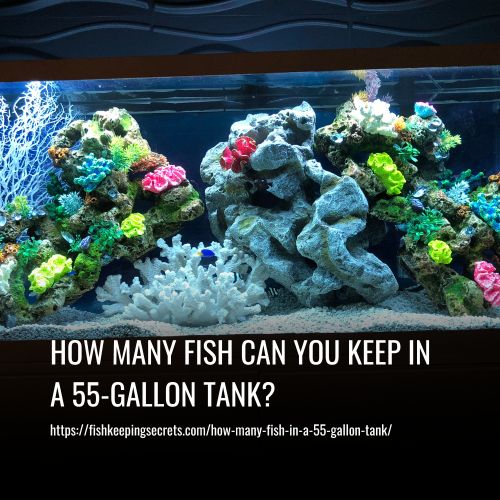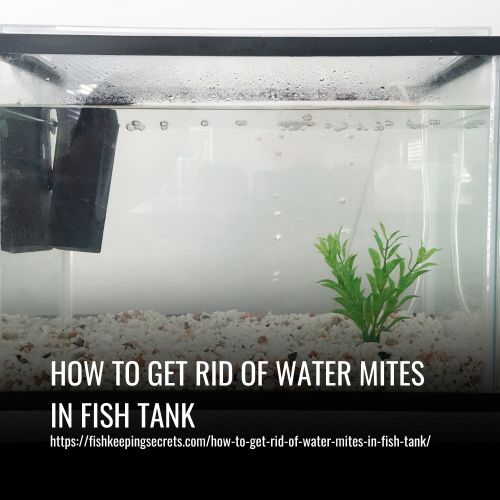How To Change Water For Betta Fish
This post contains affiliate links. As an Amazon Associate, we earn from qualifying purchases.
Changing water for your Betta Fish is one of the most important things you can do to keep it healthy. Not changing your fish’s water regularly can leave it susceptible to harmful toxins and illnesses that could easily have been avoided.
To Change Water For Betta Fish, follow these steps:
- Remove the Old Water From the Betta Fish Tank.
- Remove the Lid.
- Get a Bucket or Container.
- Use a Suction Tube.
- Remove Half of the Tank Water.
- Prepare New Water for Your Betta Fish Tank.
- Prepare a Clean Bucket.
- Use a Water Conditioner.
- Monitor the Temperature.
- Replace the Old Water With New Water.

How To Change Betta Fish Water?
Betta fish require tank water to be changed regularly; for this, you must replace the old tank water with conditioned new water. You can do this yourself by following these simple steps.
1. Remove the Old Water From Betta Fish Tank:
To remove old water from your betta fish tank, you should perform a partial water change. This process does not require that you take your fish out of the tank. Instead, follow these steps for a successful partial water change:
2. Remove the Lid:
Make sure to turn off all the lights, heaters, and filters before removing the tank lid for safety purposes.
3. Get a Bucket or Container:
Gather a bucket or container and place it near your betta fish tank. Any decorative items such as plants, rocks, fish houses, etc., should be removed from the tank beforehand.
4. Use a Suction Tube:
Before you can start cleaning your fish tank, it is important to properly prepare the equipment and suction tube or hose. To do this, place the suction tube or hose in the aquarium, making sure one end is submerged and the other end is outside of the aquarium. If you are using a hose or suction tube with siphon action, it will help you remove the uncleaned water from the aquarium more easily.
If not, you will have to manually suck on the other end of the tube or hose to remove water from your tank. It is essential that if you decide to use this method, make sure to empty out the tube or hose before it reaches your lips as sucking dirty fish tank water can be harmful to your health.
5. Remove Half of the Tank Water:
When changing the water in a fish tank, it’s important not to remove too much. It is recommended to only remove about 50% of the unfiltered water and 20% of the filtered water. This will help maintain the beneficial bacteria in your tank, which are essential for a healthy environment.
Removing too much water could lead to unhealthy conditions or adversely affect your fish. Additionally, when adding new water, be sure to use aged or dechlorinated water that is at the same temperature as the existing aquarium water.
6. Prepare New Water for Your Betta Fish Tank:
Before adding new water to your betta fish tank, it is important to make sure that the new water is conditioned properly.
7. Prepare a Clean Bucket:
When setting up a new betta fish tank, it is important to use only clean containers and buckets for preparing the water. These should preferably be exclusively used for aquariums, as regular household buckets may contain toxins and chemicals which can be dangerous for your fish.
To prepare the water, add enough clean water to the bucket or container to fill the fish tank. Tap water is safe to use, but it should be thoroughly filtered or aged before adding it to the tank. Additionally, monitor both the temperature and pH levels of the water before introducing your betta fish.
8. Use a Water Conditioner:
When adding water to your fish tank, it’s important to use conditioned water. Tap water contains chemicals such as chlorine and fluorine that can be damaging to your fish. A water conditioner can be used to remove these chemicals and make the tap water safe for your fish. You can buy a water conditioner from any local pet store, or you may even have one included in your aquarium setup kit.
Once the water is conditioned, allow it to sit for at least 24 hours before introducing your fish into the tank. This will give time for any toxins in the water to evaporate and ensure that the environment is safe for your new aquatic friends.
9. Monitor the Temperature:
When it comes to betta fish, water temperature is an important factor that must be closely watched and monitored. Bettas do not tolerate sudden changes in parameters, and any fluctuations can cause stress, making them more prone to illnesses. The ideal temperature for bettas ranges from 78-82° Fahrenheit.
Therefore, you must use a thermometer to make sure the water has reached the optimal range before introducing it into the tank. Keeping a constant and stable temperature ensures that your betta fish remain healthy and happy.
10. Replace the Old Water With New Water:
Take your time while adding the new water to avoid causing stress to your betta fish. Slowly pour it in and allow it to mix with the existing water.
Once you have added enough new water to replace the amount you removed, turn on any filters or equipment that may have been turned off during the water change.
Why Should You Change Your Bettas Water?
It is important to regularly check and maintain the water quality of your betta tank in order to keep your fish happy and healthy. This includes regularly performing partial water changes, which involve removing a percentage of the old water and replacing it with fresh, dechlorinated water.
By doing this, you can lower the amount of toxic waste that builds up in the tank, thus helping to keep the environment clean and balanced for your betta. Additionally, it’s a good idea to monitor ammonia levels in order to prevent spikes that can be potentially harmful.
With consistent care and maintenance, you can make sure that your betta tank remains a safe, stress-free space for your fish to thrive!
How Much Water Should You Change?
A water-changing checklist can help aquarium owners ensure their fish have a healthy, clean environment to live in. The amount of water that should be changed depends on two main factors: the number of tank mates and the size of the tank.
For instance, if you have several tank mates with your betta fish, more frequent water changes are necessary as toxins can accumulate rapidly. Whereas in a smaller tank, the ratio of water to toxins can become dangerous much more quickly than in a large tank.
Here is a quick guide to determine the frequency of your water changes:
| 5 gallons | 40% water change weekly |
| 10 gallons | 30% water change weekly |
| 15 gallons | 20% water change weekly |
| 20 gallons | 10% water change weekly |
If betta fish have other tank mates besides snails or shrimp, it is advisable to increase the tank size and perform water changes twice a week.
What Water Conditions Do Bettas Prefer?
Bettas are unique in that they are able to survive in a wide range of water conditions. Specifically, their native habitat is characterized by warm temperatures and soft, acidic chemistry; low levels of dissolved oxygen, GH, and KH; and an abundance of aquatic plants.
Thus, it is important to replicate these environmental parameters when keeping bettas in captivity. In addition to providing the necessary conditions for optimal health and well-being, adding aquatic plants can make your fish even happier as they act as natural biological filters and help provide extra oxygenation for the tank.
Finally, if your male betta is content enough, he may attempt to create a “bubble nest” raft using plants near the surface as anchors – a sure sign that he’s ready to start looking for a female mate!
How To Change
Once you have conditioned the new water for your fish tank, it’s time to start adding the water to the tank. Use a hose to slowly add the water, taking care not to disturb any decorations or vegetation in the aquarium.
Once all of the new water is in the tank, check the filter and make sure it isn’t clogged or dirty. If it is, clean it before putting it back in the tank.
Finally, cover the tank with its lid and turn on all of its equipment, such as lights, heating elements, and filters. Congratulations – you’re now done setting up a fresh and clean aquarium environment!
Betta Fish Water Without Siphon?
Once the desired amount of water has been removed, it is important to make sure that the water in the bucket and the fish tank both match in temperature. If not, it could cause stress or harm to your betta fish. Then, fill a container with pre-mixed dechlorinated water and slowly pour it into the fish tank until you have reached the desired level. Make sure to add any aquarium salt or additives needed for your betta fish before adding more water.
Tank or Bowl?
It is important to provide a betta fish with an appropriate home in order to ensure its health and well-being. A standard rectangular tank is usually the preferred option, as bowls, bioorbs, and vases are much too small and can become toxic very quickly.
Additionally, 100% water changes should not be used to replace partial water changes on a weekly basis. Instead, it is recommended to perform partial water changes on a regular basis in order to maintain the correct levels of water temperature, pH balance, and nitrite/ammonia levels in your tank.
Providing your betta with the best possible environment will help keep it healthy and happy.
The Role of a Filter in a Betta Tank
Filters are an essential part of any aquarium, providing a crucial role in maintaining the health and cleanliness of the water. They work by sucking up debris, waste, and uneaten food from the tank and filtering it through their systems. This helps to keep the water clean and free of harmful toxins and nitrates, which can be toxic to fish.
While having a filter does lessen the number of water changes needed, regular water changes are still necessary to maintain a healthy environment for your fish.
Additionally, proper maintenance of your filter is essential; be sure to check for clogs and replace cartridges as directed by the manufacturer’s instructions.
Benefits of Gravel Vacuuming
Regular water changes are important for maintaining healthy tank chemistry, but it is also important to remove any accumulated waste from the substrate. To do this, you can use a gravel vacuum which can suck up food and other debris between the rocks and other substrates.
By doing this regularly, you can help keep your tank’s water quality clean and stable. Gravel vacuums are widely available in pet stores and are relatively inexpensive. Additionally, it may be necessary to move any large accessories such as decorations or rocks to ensure that all debris is removed.
Taking these extra steps will help keep your tank in good condition and provide a healthy environment for your fish.
Tips to Keep the Water Clean
Keeping a healthy and happy betta fish requires some planning and effort. To ensure the tank water is safe for your betta, we recommend running both a sponge filter and cartridge filter with activated carbon and ammonia chips.
Additionally, it’s important to not overfeed your fish, as the food will start rotting in the tank otherwise. Furthermore, make sure any items removed from or added to the tank are done so with clean hands – a net can be used if needed.
Finally, and most importantly, cycle the tank properly before adding your betta. The nitrogen cycle can take up to 8 weeks to fully complete and you may need to perform small water changes each week in order to keep the water healthy and free of debris throughout this time.
By following these steps, you can create an optimal environment for your betta fish!
How Often Should You Do A Water Change?
If a filter is used, a 40% water change should be done every two to three weeks. If a filter is not used, the frequency of water changes may differ.
FAQs
Tap water is usually safe to use for betta fish, but it should be treated with a de-chlorinator to remove any chlorine and other contaminants from the water. Many dechlorinators also add beneficial minerals to the water which will make it better for your fish.
Betta fish can survive in tap water if it has been conditioned using alternative means, such as aging, ultraviolet light exposure, vitamin C supplementation, activated carbon filtration, and reverse osmosis. Every method has its own pros and cons.
Yes, you can do a full water change for your betta fish in certain scenarios. The frequency of the water changes largely depends on the size of your betta’s tank. If you have a one-bowl or pint jar, you should perform a full water change regularly. If it is a one-bowl or quart jar, you should do a full water change after a day or two.
For half-gallon bowls and one-gallon bowls, you should do a full water change two times per week and once per week respectively. It is important to research appropriate water parameters and use quality products to ensure your fish stays healthy.
Conclusion:
Overall, the process of changing the water for betta fish is a simple one that requires minimal effort and resources. The main thing to remember is to not change too much at once, as sudden changes in temperature or pH can be very dangerous for your fish.
Once you get into a regular schedule of monitoring their environment, you will soon find that keeping your betta fish healthy and happy becomes as easy as can be.






